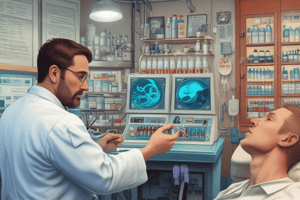Podcast
Questions and Answers
What is the mechanism of action (MOA) of local anesthetics?
What is the mechanism of action (MOA) of local anesthetics?
Local anesthetics work by blocking sodium channels in the neuronal cell membrane, preventing the initiation and conduction of nerve impulses.
Which properties determine the ability of local anesthetics to penetrate the axon membrane? (Select all that apply)
Which properties determine the ability of local anesthetics to penetrate the axon membrane? (Select all that apply)
- Concentration of the drug
- Molecular size (correct)
- Lipid solubility (correct)
- Degree of ionization at tissue pH (correct)
Vasoconstrictors increase local blood flow and reduce the duration of anesthesia.
Vasoconstrictors increase local blood flow and reduce the duration of anesthesia.
False (B)
What is a blood dyscrasia associated with benzocaine?
What is a blood dyscrasia associated with benzocaine?
What are the three main classes of opioid receptors?
What are the three main classes of opioid receptors?
What is the reversal drug for opiate effects?
What is the reversal drug for opiate effects?
Which of the following are pure opioid agonists? (Select all that apply)
Which of the following are pure opioid agonists? (Select all that apply)
What is a common adverse effect of opioids related to the gastrointestinal system?
What is a common adverse effect of opioids related to the gastrointestinal system?
Tramadol is associated with a decreased risk of seizures.
Tramadol is associated with a decreased risk of seizures.
Which of the following are characteristics of Cox-1 inhibitors? (Select all that apply)
Which of the following are characteristics of Cox-1 inhibitors? (Select all that apply)
What is an important drug interaction with Acetaminophen?
What is an important drug interaction with Acetaminophen?
Cox-2 inhibitors primarily target __________.
Cox-2 inhibitors primarily target __________.
What is a common adverse effect of glucocorticoids?
What is a common adverse effect of glucocorticoids?
What is the recommendation for tapering glucocorticoids?
What is the recommendation for tapering glucocorticoids?
Which of the following foods can trigger migraines? (Select all that apply)
Which of the following foods can trigger migraines? (Select all that apply)
Triptans are known to cause overuse headaches.
Triptans are known to cause overuse headaches.
What is the primary action of NSAIDs in treating migraines?
What is the primary action of NSAIDs in treating migraines?
The drug class known for blocking calcitonin gene-related peptide to reduce migraine frequency is called ___.
The drug class known for blocking calcitonin gene-related peptide to reduce migraine frequency is called ___.
Which of the following are contraindications for triptans? (Select all that apply)
Which of the following are contraindications for triptans? (Select all that apply)
What herbal medication used for migraines may cause gastrointestinal symptoms?
What herbal medication used for migraines may cause gastrointestinal symptoms?
Match the following abortive treatments with their characteristics:
Match the following abortive treatments with their characteristics:
What is the goal of treatment for rheumatoid arthritis?
What is the goal of treatment for rheumatoid arthritis?
Which of the following is the first-line treatment for rheumatoid arthritis?
Which of the following is the first-line treatment for rheumatoid arthritis?
What is the first-line traditional DMARD for moderate to severe rheumatoid arthritis?
What is the first-line traditional DMARD for moderate to severe rheumatoid arthritis?
Which of the following is a potential side effect of Rituximab?
Which of the following is a potential side effect of Rituximab?
All anti-TNF medications inactivate TNF.
All anti-TNF medications inactivate TNF.
The first-line preventive medication for gout is __________.
The first-line preventive medication for gout is __________.
What can excessive production of uric acid lead to?
What can excessive production of uric acid lead to?
Which of the following indications suggests the initiation of preventive treatment for gout?
Which of the following indications suggests the initiation of preventive treatment for gout?
What is the main cause of gout?
What is the main cause of gout?
Rituximab reduces the number of __________ cells.
Rituximab reduces the number of __________ cells.
Flashcards are hidden until you start studying
Study Notes
Local Anesthetics
- Block sodium channels in neuronal cell membrane, preventing nerve impulses
- Properties determining ability to penetrate axon membrane:
- Lipid solubility
- Molecular size
- Degree of ionization at tissue pH (pKa)
- Lidocaine:
- Effects prolonged with epinephrine
- Can be used for cardiac dysrhythmias, suppresses cardiac excitability
- Vasoconstrictors (e.g., epinephrine) reduce local blood flow, prolong anesthesia, and reduce systemic absorption and toxicity
- Blood dyscrasia: methemoglobinemia from benzocaine
- Application guidelines for topical anesthetics:
- Use smallest effective amount
- Apply to smallest surface area
- Avoid broken or irritated skin
- Avoid strenuous exercise
- Avoid heating site
- Do not use under occlusive dressings unless prescribed
Opioids
- Three main classes of opioid receptors:
- Mu (μ) receptors: analgesia, respiratory depression, euphoria, sedation, and physical dependence
- Kappa (κ) receptors: analgesia, sedation
- Delta (δ) receptors: do not interact with opioids
- Three classifications of drugs acting on opioid receptors:
- Pure opioid agonists (e.g., morphine, fentanyl): activate Mu and Kappa receptors
- Opioid agonist-antagonists (e.g., pentazocine, nalbuphine, butorphanol, buprenorphine): produce analgesia, but can antagonize pure agonists
- Pure opioid antagonists (e.g., naloxone, naltrexone): reverse respiratory and CNS depression caused by opioid agonists
- Opioid medications and details:
- Morphine: severe acute pain, breakthrough pain, and around-the-clock dosing
- Hydrocodone: moderate to severe acute and persistent pain
- Oxycodone: moderate to severe persistent pain
- Fentanyl: persistent pain
- Hydrocodone/acetaminophen: acute, recurrent, and episodic breakthrough pain
- Oxycodone/acetaminophen: moderate to severe pain
- Morphine:
- Pro-agonist
- Therapeutic uses: severe pain relief
- Side effects: euphoria, drowsiness, mental clouding, anxiety reduction, respiratory depression, constipation, cough suppression, biliary colic, tolerance, physical dependence, and histamine relief
- Black Box Warning: addiction, abuse, and misuse; life-threatening respiratory depression; accidental ingestion; neonatal opioid withdrawal syndrome
- Medications for opioid-induced constipation (OIC): methylnaltrexone, naloxegol, lubiprostone
- Reversal drug: naloxone
- Drug to discourage abuse: naltrexone
Nonopioid Centrally Acting Analgesics
- Tramadol:
- Suicide risk: increased in patients with depression or suicidal tendencies
- Seizure risk: increased, especially with a history of seizures or taking medications that lower seizure threshold
- Clonidine: used for hypertension and severe cancer pain (off-label)
- Ziconotide: used for severe chronic pain via intrathecal route
- Dexmedetomidine: used for sedation of patients on mechanical ventilation
Cyclooxygenase Inhibitors (Anti-Inflammatories)
- Differentiate Cox 1 and Cox 2 drugs:
- Cox-1 inhibitors (e.g., aspirin, ibuprofen, naproxen): affect protective gastric mucosa, platelet aggregation, and support renal function
- Cox-2 inhibitors (e.g., celecoxib): produced at sites of tissue injury, target inflammatory pathways, with less GI side effects but increased cardiovascular risk
- NSAIDs and Acetaminophen:
- Indications: Tx inflammatory disorders, mild to moderate pain, suppress fever, and relieve dysmenorrhea
- Examples: aspirin, ibuprofen, naproxen
- Safety alert: increased risk of GI bleeding/ulceration, renal impairment with all first-generation NSAIDs
- Second-generation NSAIDs: ONLY inhibit COX2
- Indications: suppress inflammation with fewer adverse effects, but less safe than first-gen due to increased risk of MI/stroke
- Examples: celecoxib
- Celecoxib:
- Cardiovascular risk: hypertension, edema, increased risk of MI/Stroke
- A/E: MI/Stroke, sulfonamide allergy
- Cannot be used during pregnancy
- ASA:
- Uses: analgesic, anti-pyretic, and anti-inflammatory, suppression of platelet aggregation, protection in thrombotic disorders, cancer prevention, and prevention of Alzheimer's
- Decreases risk for colorectal cancer at low dosage
- Drug interactions: increased bleeding risk with anticoagulants, corticosteroids, and alcohol
- Side effects: GI bleeding, renal impairment, Reye's syndrome in children
- Acetaminophen:
- MOA: inhibits prostaglandin synthesis in CNS
- A/E: SJS, exanthematous pustulosis, toxic epidermal necolysis, and hepatotoxicity with overdose
- Drug interactions: alcohol, warfarin, vaccines
- Vaccines: can reduce immune response to some vaccines
- Treatment for overdose: N-acetylcysteine (NAC)
Glucocorticoids
- MOA: inhibit synthesis of chemical mediators
- Therapeutic uses: anti-inflammatory and immunosuppressive effects for conditions like asthma, OA/RA, lupus, tendonitis, synovitis, gouty arthritis, and disorders of the eye
- Metabolic effects: hyperglycemia, increased fat deposition, muscle wasting, thinning of skin, growth retardation in children, cataracts/glaucoma, Cushing's syndrome
- Adverse effects: osteoporosis, adrenal suppression, increased infection risk, GI ulceration, mood changes
- Drug interactions: interact with NSAIDs, antidiabetic drugs, vaccines
- Contraindicated: patients with systemic/fungal infections, live virus vaccines, caution use with peds, pregnant/breastfeeding
- Tapering: gradual reduction in dose to prevent adrenal insufficiency, monitor for signs of insufficiency
Pathophysiology of Migraine
- Abnormal brain activity affects nerve signals, chemicals, and blood vessels in the brain, triggered by factors such as hormonal changes, certain foods, stress, and environmental factors.
Foods that Trigger Migraines
- Aged cheeses
- Processed meats
- Chocolate
- Alcohol (especially red wine)
- Caffeine
- Artificial sweeteners
Abortive Treatment Drug Classes
Triptans
- Examples: sumatriptan
- Mechanism: selective serotonin receptor agonists reducing inflammation and constricting blood vessels
- Sumatriptan:
- Adverse effects: bad taste, chest symptoms, coronary vasospasm, teratogenesis
- Contraindications: pregnancy, heart disease, not recommended for geriatric/severe liver disease/MAOIs use in past 2 weeks
- Lab tests: LFTs, creatinine clearance
- Other triptans: zomitriptan (oral and intranasal, tastes bad), frovatriptan (longest half-life: 26 hours)
Ergot Alkaloids
- Examples: ergotamine
- Mechanism: constricting blood vessels in the brain
- Ergotamine:
- Adverse effects: muscle pain, paresthesia, cold extremities, physical dependence
- Contraindications: hepatic/renal impairment, CAD, PVD, pregnancy
- Interactions: contraindicated with potent inhibitors of CYP (protease inhibitors, azole antifungals, and some macrolides)
NSAIDs
- Examples: ibuprofen, naproxen
- Mechanism: reducing inflammation and pain
- Treximet: combination of sumatriptan and naproxen
- Urbogepant:
- Can be used during breastfeeding
- Interactions: azoles, macrolides, floxins, grapefruit juice
- Rimegepant:
- Can be abortive and preventive
- Dose: 75mg as needed, 75mg every other day (preventive)
- Lasmitidan:
- First in class Serotonin 1F receptor agonist
- Adverse effect: drowsiness in geriatric
Overuse Headaches
- All abortives can cause overuse headaches, which can be prevented by taking preventive medications.
Preventive Medications
Beta-Blockers
- Examples: propranolol
- Mechanism: reducing frequency and severity of migraines
Antiseizure Medications
- Examples: topiramate, divalproex, tiagabapine
- Mechanism: stabilizing nerve cell membranes
CGRP Monoclonal Antibodies
- Examples: erenumab
- Mechanism: blocking calcitonin gene-related peptide to reduce migraine frequency
- Dose: subq injection dosed once monthly
- Atogepant:
- Oral
- Renal dosing
Antidepressants
- Examples: amitriptyline
Botulinum Toxin
- Requires a lot of injections
- Variable effects
- Expensive
Herbal Medications
- Butterbur: potential liver toxicity
- Feverfew: gastrointestinal symptoms, mouth ulcers
- Magnesium: diarrhea
- Riboflavin (Vitamin B2): generally well-tolerated
Treatment for Menstrual Migraine
- NSAIDs
- Triptans
- Hormonal therapy (e.g., estrogen patches)
Rheumatoid Arthritis (RA)
- Autoimmune disorder characterized by chronic systemic inflammation of multiple joints' synovial membranes
- Shortens lifespan and increases risk of cardiovascular disease and stroke
- Goal of treatment: reduce inflammation and pain while preserving function and preventing joint damage/deformity
Treatment
- First line treatment: NSAIDs with Disease-Modifying Antirheumatic Drugs (DMARDs)
- Traditional DMARDs:
- Methotrexate (1st line for moderate-severe RA) with risks of bone marrow suppression, hepatic fibrosis, GI ulceration, and pneumonitis
- Hydroxychloroquine (2nd line for mild RA) with risk of retinal damage
- Leflunomide (teratogenic)
- Sulfasalazine (GI effects)
- Minocycline
- Penicillamine
- Azathioprine
- Cyclosporine
- Biological response modifiers:
- Risk of cancer and infections
- Receive all recommended vaccinations
- Yearly TB testing required
Non-TNF Biological Response Modifiers
- Rituximab:
- Reduces number of B lymphocytes
- Adverse effects: infusion reactions, mucocutaneous reactions, Hep B reactivation, progressive multifocal leukoencephalopathy
- Abatacept:
- T-cell activation inhibitor
- Adverse effects: headaches, upper respiratory infections, nasal pharyngitis
- Avoid live vaccines
- Anakinra:
- Blocks receptors for interleukin 1
- Adverse effects: infections
- Tocilizumab:
- Interleukin-6 receptor antagonist
- Adverse effects: infections, GI perforation, liver injury, neutropenia/thrombocytopenia
Anti-TNF Biological Response Modifiers
- Inactivate TNF
- Examples:
- Etanercept:
- Adverse effects: infections, heart failure, hematologic disorders
- Avoid live viruses
- Infliximab
- Adalimumab
- Certolizumab
- Golimumab
- Etanercept:
Oral JAK Inhibitors
- Tofacitinib
- Ruxolitinib
Gout
- Caused by excessive production of uric acid and impaired renal excretion
- Common in great toe
- Preventive medications:
- Xanthine oxidase inhibitors (agents that decrease uric acid production):
- Allopurinol:
- First-line treatment
- Inhibition of xanthin oxidase
- Adverse effects: hypersensitivity with HLA-B allele (Asian/AA decent must have HLA testing)
- Dosage: 100mg or less daily, increases every 2-5 weeks for urate level
- Allopurinol:
- Xanthine oxidase inhibitors (agents that decrease uric acid production):
Studying That Suits You
Use AI to generate personalized quizzes and flashcards to suit your learning preferences.




